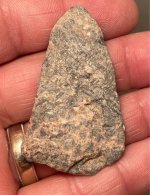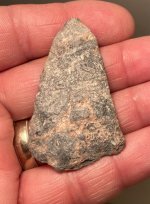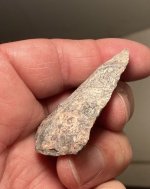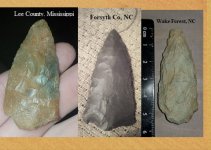Charl
Silver Member
This turned up yesterday at one of my sites. It resembles, very much, a Morrow Mountain Type 1, and even displays an aspect rarely seen on these points: a barbed or “hanging” shoulder. At least according to projectilepoints dot net:
Morrow Mountain Projectile Pointdevekiped
The distribution map shows Morrow Mountain points in southern New England, but, according to Noel Justice’s cluster model typology, this is only the case with Morrow Mountain Type 2. Indeed, in New England, the correlate for Type 2 is the fairly common Stark Point. They may have developed independently, or may have been derived from Morrow Mountain Type 2. But, Boudreau’s New England typology does not even include Type 1 as an occasional rare find here. Yet, I seem to have found a few in RI over the years, including yesterday. The link does show one Southeastern example with a “hanging” shoulder, or barb. The other shoulder on my find is dinged, but seems likely that it too would have been barbed...
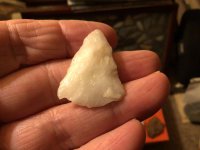
From another one of our RI sites, this rhyolite point sure looks like a Morrow Mountain Type 1 as well, but without barbed shoulders...
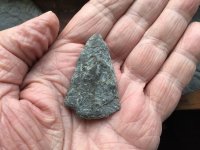
Morrow Mountain Projectile Pointdevekiped
The distribution map shows Morrow Mountain points in southern New England, but, according to Noel Justice’s cluster model typology, this is only the case with Morrow Mountain Type 2. Indeed, in New England, the correlate for Type 2 is the fairly common Stark Point. They may have developed independently, or may have been derived from Morrow Mountain Type 2. But, Boudreau’s New England typology does not even include Type 1 as an occasional rare find here. Yet, I seem to have found a few in RI over the years, including yesterday. The link does show one Southeastern example with a “hanging” shoulder, or barb. The other shoulder on my find is dinged, but seems likely that it too would have been barbed...

From another one of our RI sites, this rhyolite point sure looks like a Morrow Mountain Type 1 as well, but without barbed shoulders...

Upvote
0


